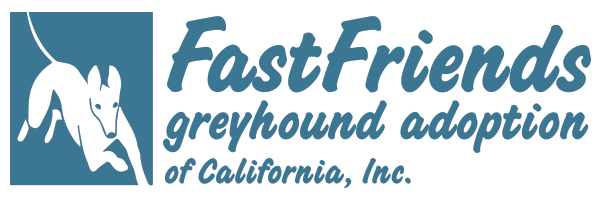Gardening and Greyhounds
by Sandy Hightower
As an avid gardener, I was a little disappointed in the look of my backyard after a few months of having my two active greyhounds, Reggie and Cantel, and usually one or two fosters. My dainty annual flowers had been used as a dog bed, bushes were munched on, and the lawn had large yellow spots and was thinning. After experimenting over the course of a year with various plants, designs and surfaces, I have finally come up with a garden that my dogs love and in which I enjoy being. Tender plants and grasses were replaced with heavy duty, vigorously growing ones and these seem to mutually coexist with my dogs, since the constant abuse keeps their invasive nature in check. I also added some pea gravel areas that contain lots of flowering shrubs and fruit trees to entice the dogs into the area to do their business.
Cantel loves to participate in the gardening activities, so I put her in the house when putting in new plants. She will unearth the whole lot in less than ten seconds. Sometimes I can distract her by giving her one of the extra kneeling pads, which is a good dog toy bargain at 99 cents.
Perennials that seem to bounce back quickly include daylilies, geraniums, bearded irises, society garlic, lavender, mexican bush sage, star jasmine, cannas, mexican evening primrose and jupiter’s beard (centranthus ruber). Shrubs with attractive flowers that thrive in my yard include cape mallow, cape plumbago and hibiscus. A good rule of thumb is, if it grows well on the side of the street or on the edges of parking lots, it can probably live with your greyhounds.
My greyhounds love to chase each other around the yard, and they especially love to chase each other around large bushes or trees. To make for more interest than a large expanse of grass that will never look like a well-manicured golf course, add beds containing flowering shrubs or specimen trees, right in the middle of the yard. Leaving a pathway along the perimeter of the yard, allows for running and games of chase around various areas, providing interest for the dogs as well as the gardener.
Grasses that seem to do best with dogs are those that regenerate and spread through runners, such as bermuda or St. Augustine. There are products on the market that lower the alkalinity of the dog’s urine, but I personally have not tried them, after reading some articles online that it is mostly the nitrogen overload that causes the burn in a lawn, not the alkalinity. The solution most commonly mentioned is watering the lawn twice a day, which goes against general water conservation and healthy lawn recommendations which are to water deeply and less frequently to encourage deep rooting. My solution was to have mostly male dogs, since they tend to urinate on the bushes or trees and I hand water my female’s spots if I’m around to see them. If you are through with the battle for a perfect lawn, don’t underestimate how beautiful a garden with winding pea gravel, bark mulch or decomposed granite pathways can be. As long as there are plenty of lush mounds of bushes and perennials, it will still be a garden, even without the grass.
Things to avoid in a garden with greyhounds:
Cocoa mulch – Highly toxic to dogs.
Pesticides – Just are not safe for greyhounds. Snail bait is very enticing to dogs, looks like kibble, and is a common poison problem seen at veterinary offices.
Herbicides – This includes “Weed & Feed” type fertilizers.
Plants with thorns or spikes - Palms, roses, bouganvilla, cactus plants. Keep these fenced off or pruned up to avoid injury.
Poisonous plants – Here is a short list of common western landscaping plants that are poisonous to dogs. For a comprehensive list, a quick internet search will yield many detailed listings. Chances are your garden contains at least one of these plants, mine contains four of them. The key is to be aware of what your dog eats, which parts of the plant are toxic, and the level of toxicity in the plant.
Angels Trumpet
Asparagus Fern
Caladium
Calla Lily
Cyclamen
Elephant Ears
English Ivy
Foxglove
Fig, Creeping
Foxglove
Heavenly Bamboo
Hydrangea leaves
Ivy
Lantana
Larkspur
Mother-in-law's Tongue
Morning Glory
Oleander
Philodendron
Poinsettia
Pothos
Primrose
Rhododendron
Sago Palm
Tomato Plant (green fruit, stem and leaves)
Wisteria
Yew (American, English, Western)
